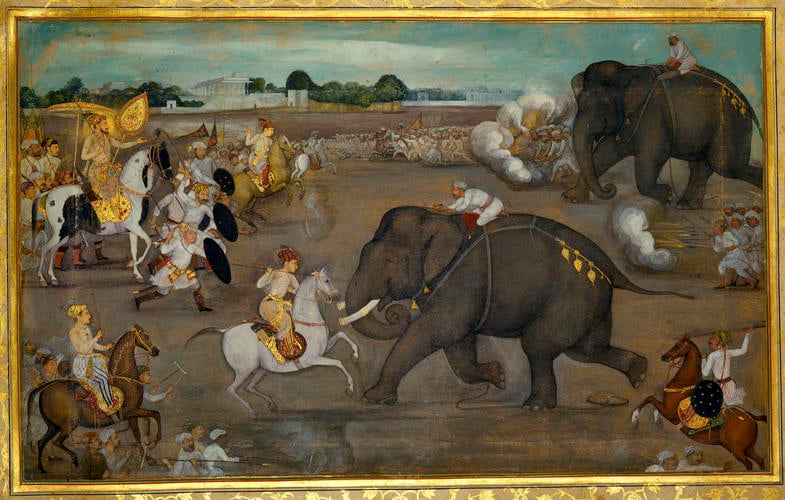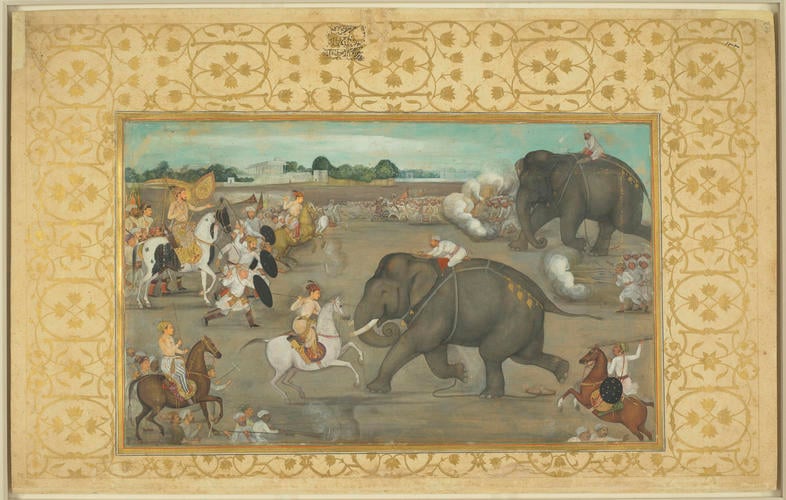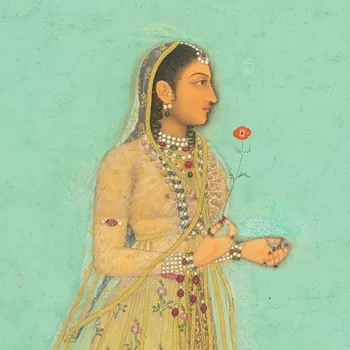Prince Awrangzeb facing a maddened elephant named Sudhakar (7 June 1633) c. 1635 - 1640
Painting in opaque watercolour including metallic paints. | 24.3 x 40.2 cm (image) | RCIN 1005025.ad

Mughal artist
Master: Padshahnamah ?????????? (The Book of Emperors) ?? Item: Prince Awrangzeb facing a maddened elephant named Sudhakar (7 June 1633) c. 1635 - 1640

Mughal artist
Master: Padshahnamah پادشاهنامه (The Book of Emperors) Item: Prince Awrangzeb facing a maddened elephant named Sudhakar (7 June 1633) c. 1635 - 1640



-
Padshahnamah fol. 134v
(plate 29)
Shah Jahan witnesses Prince Awrangzeb repel the maddened elephant Sudhakar on 7 June 1633.
The only landscape-format painting in the Padshahnamah manuscript, this image symbolises the strength and vigour of the Mughal dynasty as Shah-Jahan observes his son Awrangzeb thrust a spear into the trunk of a charging elephant. In the text, the prince’s bravery is linked to the Emperor’s own display of prowess when he killed a lion as a prince, the scene depicted in the following painting (RCIN 1005025.ae).
The event took place along the wide banks of the River Jumna at Agra on 7 June 1633, when the water level was at its lowest before the monsoon rains. The Emperor watched fights between war elephants on most days when in Agra, a pastime which, like hunting lions, was an imperial privilege. On this occasion, Shah-Jahan and his sons watched the fight from the haveli (mansion) to the north of the fort in which he had lived as a prince and later gave to Awrangzeb. As customary, the two imperial elephants were intoxicated before being brought together to fight. During the contest they moved out of view back towards the fort, and the Emperor ordered horses to be fetched so that he and the Princes could continue to follow the action. When they got near, the elephant named Sudhakar ‘made mighty charges and violent motions’ and ran in the direction of Prince Awrangzeb. In the painting, Sudhakar’s mahut has dropped a log at the end of a long chain tied to the elephant’s foot designed to make the beast trip, but without effect. Awrangzeb stood his ground, firmly clenching his reins, as the elephant came near and, according to the text, thrust a spear into the animal’s forehead. The painting truthfully shows blood leaking from the elephant’s forehead but depicts, perhaps fictitiously, Awrangzeb spearing its trunk so that the animal and the prince are shown with their eyes level. Shah-Jahan watches the scene from his piebald horse on the left, flanked by the imperial insignia of the parasol and sunshade.
As suggested on the right of the painting, the discharge of fireworks to drive the elephants back created a smoke so dense that it was almost impossible for the foot soldiers to see, which is why two in the central group have tripped. Just above Awrangzeb, Prince Shah-Shuja gallops to his brother’s aid but his horse spooks at a firework. Both he and Awrangzeb fell from their saddles but were pulled from harm’s way by Mirza Rajah Jai Singh I of Amber, shown here, lance in hand, at the lower right corner.
This is one of few paintings in the Padshahnamah manuscript to depict shadows, the single light source apparently being the Emperor’s gleaming aureole. The artist also uses colour perspective to separate the fore-, middle- and backgrounds, with the blue tinge of the distant garden pavilions almost fading into the horizon. In contrast to the bold depiction of the key figures, the almost ghostly foot soldiers dressed in white are barely visible through the smoky fireworks. This play of illusion heightens the sense of confusion on the ground while the mounted members of the imperial family appear resolute and steadfast.
A drawing based on this painting was sold at Sotheby’s on 11 April 1988, lot 16.
Bibliography:
Milo Beach and Ebba Koch, King of the world : the Padshahnama, an imperial Mughal manuscript from the Royal Library, Windsor Castle, 1996
Saqib Baburi, Beyond the Akbarnamah: Padshahnamahs and Official Regnal Chronography for Shah-Jahan Padshah (r. 1037/1628-1068/1658), 2010.Provenance
Illustration from a Padshahnamah manuscript formerly in the Mughal imperial library and acquired by Asaf al-Dawlah, Nawab of Awadh, c.1780-90; presented by Saadat Ali Khan, Nawab of Awadh, to George III via Lord Teignmouth in June 1799.
-
Creator(s)
(artist)Acquirer(s)
-
Medium and techniques
Painting in opaque watercolour including metallic paints.
Measurements
24.3 x 40.2 cm (image)
36.8 x 58.4 cm (page dimensions)
Category










